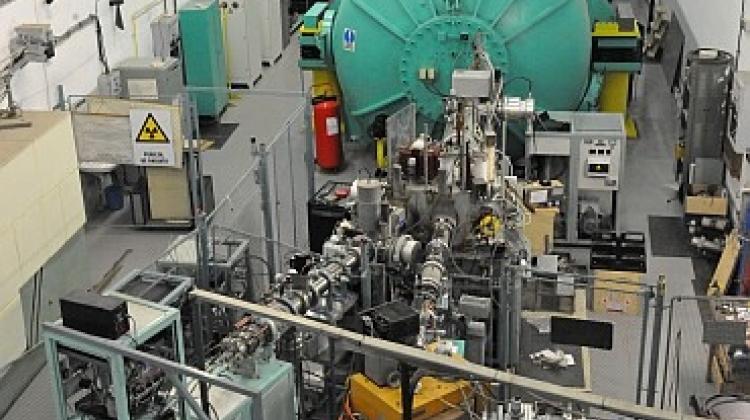The first light atomic nucleus with second face

When the nucleus of the atom is excited, its shape can change for a very short period of time. Until now, this phenomenon has been observed in the most massive elements. Finally, however, the researchers - including Polish scientists - managed to observe the "second face" of a light nucleus.
With some approximation, atomic nuclei look like balls, in most cases more or less misshapen. When the nucleus is excited, its shape may change, but only for an extremely brief moment, and then it returns to its original state. Nuclei can change their shape depending on the amount of energy they have or the speed at which they rotate. Changes associated only with the addition of energy (and thus without taking rotation into account) are relatively stable only in the nuclei of the most massive elements.
Now it turns out that the nuclei of much lighter elements, such as nickel, may also remain in their new shape a little longer. The discovery has been made by a team of scientists from Italy (UniMi), Poland (Institute of Nuclear Physics PAS in Kraków), Romania (IFIN-HH), Japan (University of Tokyo) and Belgium (Free University of Brussels).
The calculations necessary to prepare the experiment proved to be so complex that a computer infrastructure of about one million processors was needed to perform them. The effort did not go to waste: the publication describing the achievement was distinguished by the editors of the prestigious Physical Review Letters (https://journals.aps.org/prl/abstract/10.1103/PhysRevLett.118.162502). Representatives of the Institute of Nuclear Physics PAS informed about the research in a release sent to PAP.
FUSSY BALL
Most atomic nuclei are deformed to a greater or lesser extent, oblong or elongated along one, two, and sometimes even all three axes. What\'s more, just like a ball flattens more or less depending on the force applied to it by the hand, atomic nuclei can change their deformation depending on the amount of energy they have, even when they do not rotate.
"When the atomic nucleus is supplied with the right amount of energy, it can go into a state with a different shape of deformation than the shape typical for its basic state. This new deformation - illustratively speaking - a new face - is very unstable. Like a ball after removing the hand that had deformed it before, the nucleus returns to its original form, but it does that much, much faster, in the order of billionth of parts of a billionth of a second, or even faster. Instead of the second face of atomic nucleus, it\'s probably better to talk about a grimace..." - described Prof. Bogdan Fornal (Institute of Nuclear Physics PAS).
HEAVY NUCLEI SHOW THE SECOND FACE
In the last few decades, evidence has been gathered that a relatively stable state with a deformed shape is present in the nuclei of a small number of elements.
Measurements have shown that the nucleus of some actinides - elements with atomic numbers from 89 (actinium) to 103 (lawrencium) - are capable of holding their "second faces" up to tens of millions of times longer than the other nuclei. Actinides are elements with a total number of protons and neutrons well above 200, so they are very massive. An excited state with a deformed shape characterized by increased stability has never been observed before among the non-rotating nuclei of lighter elements.
WHAT HAPPENS IN NICKEL?
Prof. Fornal and Prof. Michel Sferrazza (Free University of Brussels) pointed out already three decades ago that the theory allowed for the existence of stable deformed shape states in the nuclei of light elements. Their attention turned to nickel-66.
An experiment in this area was performed only recently. At the accelerator in Bucharest, a nickel-64 shield was bombarded with oxygen-18 nuclei. During these collisions, nickel-66 can form, and its nucleus in its basic shape resembles an almost perfect ball. With properly selected collision energies, a small portion of Ni-66 nuclei enter a certain state with a deformed shape that, as the measurements show, is slightly more stable than all other excited states associated with significant deformation. In other words, the nucleus was in a local, deep minimum of potential.
"The measured extension of life span of the deformed shape of the Ni-66 nucleus is not as spectacular as that of the actinides, where it reached tens of millions of times. We recorded only five-fold growth. Nevertheless, the measurement was exceptional, because it was the first observation of its kind in light nuclei" - concluded Prof. Fornal
PAP - Science and Scholarship in Poland
lt/ agt/ kap/
tr. RL
Przed dodaniem komentarza prosimy o zapoznanie z Regulaminem forum serwisu Nauka w Polsce.















